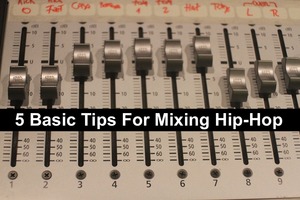- in Book Excerpt , Engineering , Production by Bobby Owsinski
5 Basic Tips For Mixing Hip-Hop
 It’s fair to say that most people reading my Mixing Engineer’s Handbook are mixing songs recorded with live musicians, but it’s a brave new world out there, and sooner or later you’re going to get some hip-hop in to mix. Needless to say, what works with most other genres won’t necessarily work here, especially when it comes to overall mix balance. Here are a few very basic but essential tips that will help your mix fit with rest of the genre.
It’s fair to say that most people reading my Mixing Engineer’s Handbook are mixing songs recorded with live musicians, but it’s a brave new world out there, and sooner or later you’re going to get some hip-hop in to mix. Needless to say, what works with most other genres won’t necessarily work here, especially when it comes to overall mix balance. Here are a few very basic but essential tips that will help your mix fit with rest of the genre.
1. Keep the vocals up front. Hip-hop is very much like pop in that the vocals are always very forward in the mix. Where in rock the lead vocals are pulled back in order for the band to sound more powerful, that’s not the case here. It might even be a good idea to begin the mix with the vocal to make sure that everything stays in the proper balance for the genre.
2. Keep the kick as loud as the vocal. In hip-hop the rhythm centers around the kick and it’s the most important mix element after the vocals. If the track consists of a loop or loops, you might want to augment what’s already there with a kick sample in order to keep it at the right level in the mix and to augment the sound.
3. The snare sound is important too. The element that represents the snare may not be a traditional snare drum. It could be handclaps, shaped noise, 808, or any combination of elements to make up the high frequency beat 2 and 4 element. In other music genres the snare sound provides the backbone of the rhythm of the song – the pulse. In hip-hop that still happens but the level is usually lower than the kick.
4. The other mix elements are sweeteners. There may be an important sample or synth line that’s meant to be a hook, but everything else is just meant as a texture or to augment the groove. Panning is important here because sometimes the elements are more for interest that support and the panning enhances that.
5. Be careful with the ambience. Most mixers take time to wash a vocal in an elaborate bath of effects meant to enhance its presence in the track. That can happen in hip-hop sometimes too, but usually the vocal is a lot dryer than in other genres. Yes, you’ll get the occasional delay-throw to fill up a space between a phrase, but you’re not going to find many mixes with 3 and 4 second reverb decays on the vocals or the other mix elements.
Obviously not every song or production is the same and there are always exceptions to the above, but you’ll find that if you want your mix to fit the genre, following these above steps will help.
You can read more from The Mixing Engineer’s Handbook and my other books on the excerpt section of bobbyowsinski.com.

